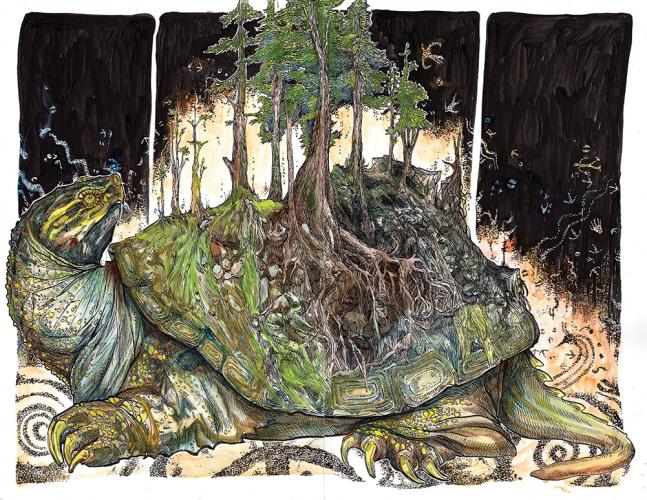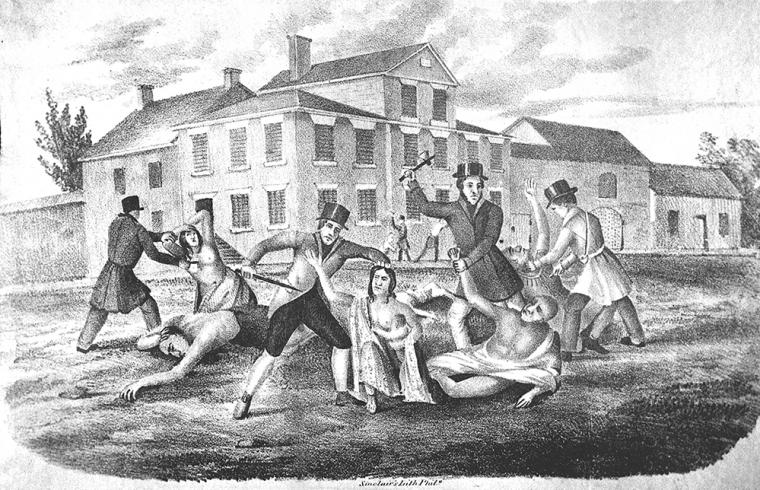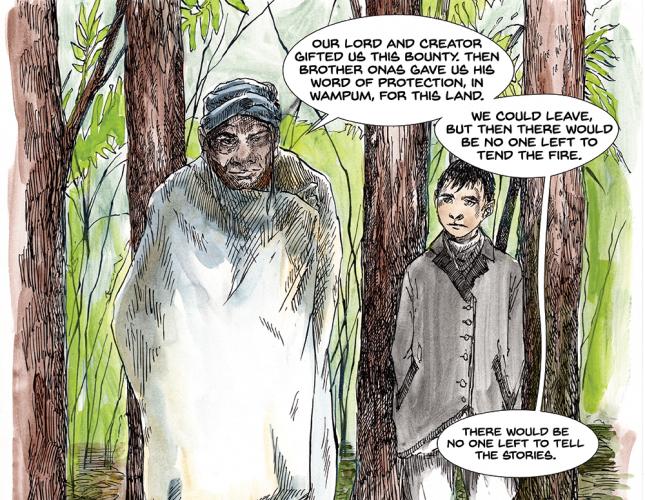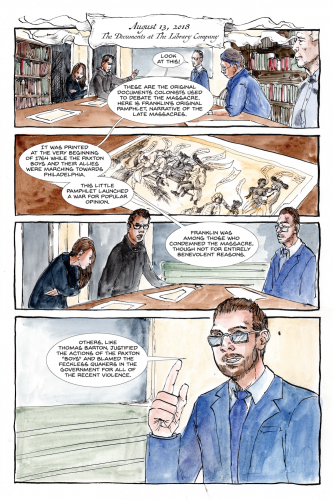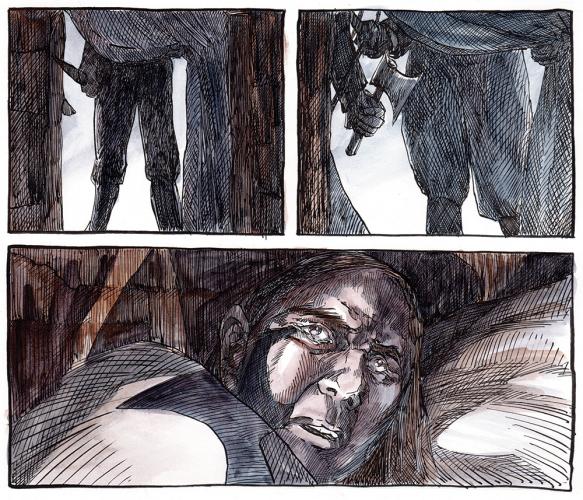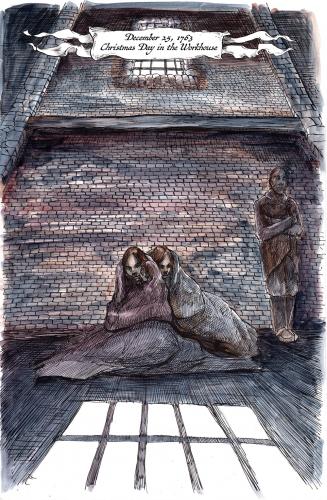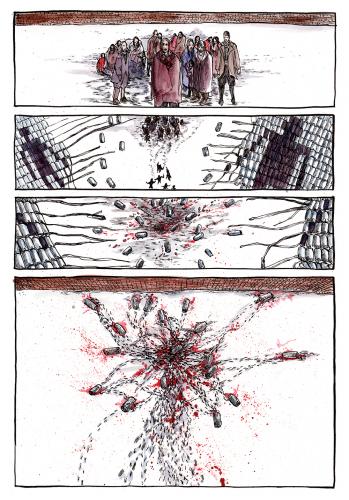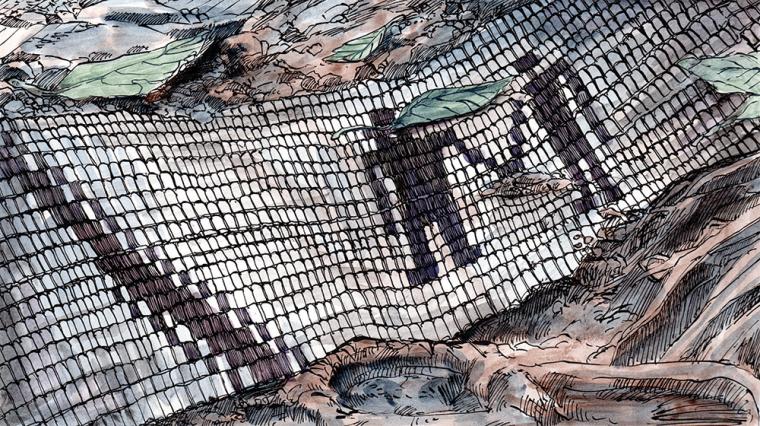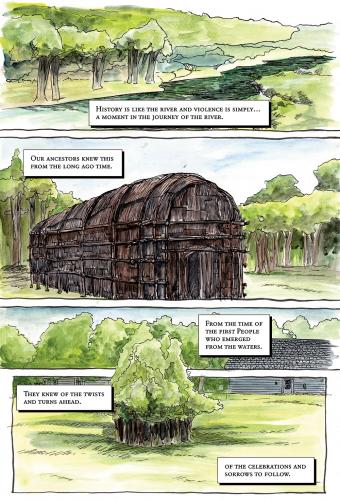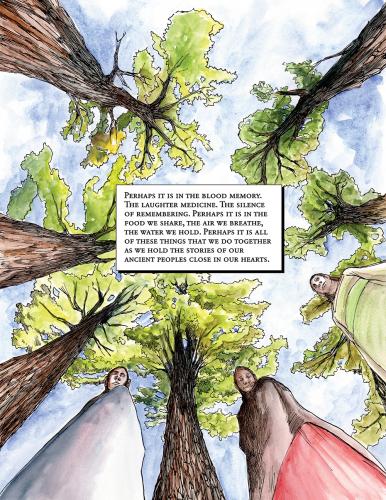Everything about the Paxton Boys episode was ugly. In 1763, a mob of Scots-Irish colonists from Paxtang Township, Pennsylvania, vented their anger from the recent French and Indian War on the unarmed Conestoga tribe, which was living along the Susquehanna River in the southeast corner of the state. The colonists massacred 20 Indian men, women and children during two separate episodes, first in the tribal village and then while the Conestoga were in the colonists’ nearby township. These violent acts wiped out an entire tribe, yet no one was held accountable.
A graphic novel might seem an odd choice to examine this disturbing chapter in American history, but Will Fenton, the director of Scholarly Innovation at The Library Company of Philadelphia, shows otherwise. Fenton’s brainchild—“Ghost River: The Fall and Rise of the Conestoga,” is a provocative depiction of the incidents from the Conestoga people’s perspective, a tale that eerily echoes difficult themes present in society today. The 60-page graphic novel with another 60 pages of back matter will be published in December. It is being distributed free to all 573 federally recognized tribes in the United States.
The publication is part of the Library Company’s two-year-long initiative, Redrawing History: Indigenous Perspectives on Colonial History, which is funded by The Pew Center for Arts & Heritage. The National Museum of the American Indian’s education staff served as an advisor on the project. The Library Company is also offering a slate of related public programs and an exhibition as well as archival documents and other resources offered through its online humanities project entitled Digital Paxton (digitalpaxton.org).
Fenton stumbled upon this little-known event two years earlier while researching his early American literature dissertation. In January 1764, after the attacks on the Conestoga, Benjamin Franklin intercepted 250 “Paxton Boys” on their way to Philadelphia to confront predominantly Quaker authorities. The French and Indian War had ended just months before, yet the settlers felt these leaders had not done enough to protect frontier Scots-Irish and German farms from acts of aggression by other Indian tribes during and after the war. The mob dispersed when Franklin convinced them that their grievances would be investigated. A virulent battle of words later erupted, catalyzed by a pamphlet in which Franklin called the Paxton Boys “White Savages.” Hundreds of pamphlets, political cartoons, broadsides and letters followed, fueling a heated public debate that provides rich insight into the colonists’ feelings about race and what it meant to be a Pennsylvanian on the eve of the American Revolution. The back-and-forth was the social media interaction of its day.
In that vigorous colonial debate, Fenton found the absence of the Conestoga perspective particularly disturbing. That’s when the idea of a graphic novel came up: it seemed an ideal platform to reach a broad audience and tell the story from the Indigenous point of view. The Conestoga left very few written documents, so the idea of using a mix of words and images that echoed oral storytelling traditions seemed an effective format. Also, the novel form enabled the narrative to jump episodically between the past and present, even incorporating the very act of writing the book into its pages.
Fenton enlisted Laguna Pueblo writer Lee Francis IV and Tongva artist Weshoyot Alvitre to create the graphic novel. The creative team faced a large hurdle: the absence of virtually any primary sources from the Conestoga Indians. So the trio traveled to the site of the two massacres. They spoke with scholars, interviewed and enjoyed potlucks with Lenape and other local Indigenous community leaders, worked with an advisory council and examined wampum belts, diaries and contemporary political cartoons. Timothy Truman, renowned writer and illustrator of the “Scout” comic book series, also generously shared his knowledge about Indigenous lifeways, material culture and dress.
“The conventional history says that the Conestoga were all wiped out, end of story,” says Fenton. But many Conestoga intermarried with the neighboring Lenape, so their kin and traditions do live on. “As a result, I feel we have an obligation to the people today to tell their story,” he says. But then how to tell it with a fresh perspective and not let the conventional colonial narrative hijack the story? After all, the Paxton Boys have often been cast as heroes, or at least the only important players in those disturbing events. They began by creating complex Indian characters.
“Indians get too often stereotyped as either savages or victims,” says Francis, who founded the Indigenous Comic Con (now Indigenous Pop X, or IndigiPopX). He says those perspectives offer no complexity, no room for real people, so he made a point to give the Conestoga in “Ghost River” names, personalities and realistic feelings. “I may not have documentation of their thoughts when the Quakers confined the remaining Conestoga in Lancaster after the first attack, but the human response by anyone to that situation would be, ‘Whoa! What’s going on here?’”
To emphasize that the Conestoga weren’t merely victims, Francis depicts them standing firmly on their feet, although the record remains unclear about how events exactly unfolded. And so that the Paxton Boys do not take over the story, Francis has chosen to obscure the faces of the murderers. That enabled the narrative to keep the story focused on the Conestoga themselves.
He also didn’t want to dwell on dead bodies. Alvitre, of the Tongva people in Ventura, California, came up with the idea to portray the massacre scenes through a wampum belt—beads strung together that told stories, honored relationships and treaties and often served as currency. By revealing the bodies in the beadwork, Alvitre illustrated the violence through the eyes of the Conestoga people.
Alvitre has drawn every illustration by hand. She found an extra-fine ink nib from the 1880s at a flea market, which enabled her to create illustrations that mimic 18th-century typeset documents. “You can see inadvertent small ink blobs, just like you see in the archival material,” she notes. She spent hours detailing every single brick in the colonial houses and buildings so the reader experiences the claustrophobia that the Conestoga felt as they moved from open forest to city streets. Alvitre tracked down an Oregon “pigment hunter,” who scavenges wild berries, fossilized minerals and plants to create pigments rich in organic, earthy colors. She decided to eschew digital shortcuts and use only these natural pigments to give the novel an authentic historic feel.
The project required intense collaboration, and the team vigorously debated how the book would open. They finally settled on an approach that would take the long view, with an image of an origin story common to many eastern tribes. Turtle Island features the world on the shell of an enormous reptile. Voluptuously rich in detail, the image sucks the reader right into the powerful story.
The book’s title, “Ghost River,” also came out of shared discussion. During the group’s field trip to central Pennsylvania, their bus repeatedly crossed over the Susquehanna River. They joked about the ubiquity of the river. It finally struck them that the Susquehanna served as the perfect metaphorical thread tying the past to the present. The river then as today served as a lifeline, a major source of transportation, agriculture and recreation. Water breaks down all sorts of racial barriers because everybody needs it.
The novel’s last scene remains Francis’ favorite: contemporary American Indians stare at the reader, while behind them, their ancestors look on. “This book is about honoring those ancestors,” he says. Alvitre echoes those sentiments. “We can humanize people so often dehumanized,” she says. “That’s the first step in healing.” And, she adds, “we can learn from them so this never happens again.”
The novel begins simply with the words, “History is complicated. Violence is simple.” Today, as during the era of the Paxton Boys, notes Francis, “we default to violence because we can’t deal with talking about the complexities of the situation.” He believes that this book will take one step toward acknowledging those very complexities.
For Fenton, this project has an important social justice component. “It’s tempting to see white supremacy as a recent or contemporary problem, but the ‘Ghost River’ story reveals that it is interwoven into the fabric of our foundational mythologies.” The Paxton debate, after all, cohered a politically and ethnically diverse colonial population of Scots-Irish, Germans and English into “white” settlers besieged by a foreign adversary in their midst. “By focusing on the Indigenous peoples at the center of this tragic story,” he says, “‘Ghost River’ equips modern readers to dispel the doublespeak— to see past violence in the name of law, order, faith, family and security—to discern the humanity of our neighbors, and to redouble our efforts towards an inclusive, multiracial democracy.”

